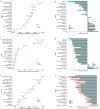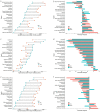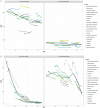Prioritizing non-communicable diseases in the post-pandemic era based on a comprehensive analysis of the GBD 2019 from 1990 to 2019
- PMID: 37587173
- PMCID: PMC10432467
- DOI: 10.1038/s41598-023-40595-7
Prioritizing non-communicable diseases in the post-pandemic era based on a comprehensive analysis of the GBD 2019 from 1990 to 2019
Abstract
This study aimed to assess the burden of communicable diseases (CDs) and non-communicable diseases (NCDs) globally, regionally, and nationally from 1990 to 2019, and propose global strategies to transform the public health policy. Using data from the Global Burden of Disease Study (GBD) 2019, we analyzed CDs and NCDs across various factors such as sex, age, year, and location, and evaluate the temporal trends of these diseases with joinpoint analysis. We also examined the differences between regions based on their socio-demographic index (SDI). In 2019, there were 7,862,907 (95% uncertainty interval [UI], 7,183,475 to 8,654,104) deaths from CDs and 42,034,124 (40,081,323 to 43,942,475) deaths from NCDs recorded worldwide. The low SDI region had markedly high age-standardized death and DALY rates of CDs. Although the age-standardized incidence rate of CDs has decreased in about half of the regions since 1990, NCDs have been on the rise in most regions. Over the past 30 years, the global burden of CDs has decreased significantly, while the burden of NCDs has aggrandized to an extent. In the post-pandemic era, effective interventions and cooperation among countries should be promoted to allocate medical resources more reasonably and improve healthcare for NCD patients.
© 2023. Springer Nature Limited.
Conflict of interest statement
The authors declare no competing interests.
Figures












References
Publication types
MeSH terms
LinkOut - more resources
Full Text Sources
Miscellaneous

